UAF Dashboard Overview
An overview of the UAF Dashboard and creating a UAF View.
| Navigate to UAF Dashboard | How to apply and navigate to the UAF Dashboard. |
| UAF Widgets | An overview of the widgets available on the UAF Dashboard. |
| Create a UAF View | How to create a UAF View. |
Please note, UAF is available in Innoslate v4.9.
The UAF Dashboard functions as the central hub for all the UAF views in an Innoslate project. This dashboard provides users with abilities to create, modify, organize, search, and filter their UAF views in their Innoslate project. Additionally, users have the option to customize this dashboard and save the layout for their team to access.

Navigating to UAF Dashboard
The UAF Dashhboard can be found under the 'MENU' dropdown on the top left of the navigation bar, under the 'Specialized' heading.

Note, upon selecting the UAF Dashboard, a window will pop up to update the Schema to the project database to reflect the UAF Schema. Select Update to apply this change.
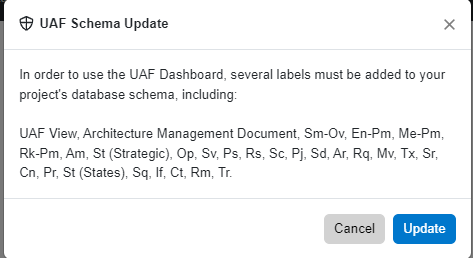
Widgets on the UAF Dashboard

There are 2 types of widgets available on the UAF Dashboard. The 'All Existing UAF Views' Widget and a widget for individual UAF views called a 'UAF View Card.' Innoslate users can modify their Dashboards with these widgets and drag them around and lay them out as they desire. The 'All Existing UAF Views' widget is automatically defaulted to be added to the UAF Dashboard.
Note, users may save their layouts on their Diagrams Dashboard. When a change is made on the dashboard, Innoslate will recognize a change and the 'Save Dashboard Layout' option will appear.

Adding a UAF View Card
To add individual widgets use The ‘Add Widget’ button on the top right of the UAF Dashboard.

A pop up appears allowing users to select which UAF view's card to add to their Dashboard:

After selecting a UAF View, take note of the 'Save to project' toggle on the top right of the window. When enabled, all users who have access to the project will be able to view the specific view on their UAF Dashboard.
UAF Card Editing Options

- Lock

Locking a UAF Card will lock its place the UAF Dashboard.
- Edit Entity

This allows the below popup to appear to change the View's root entity's Name, Number, Description or Labels.

Note, labels are imperative for the View to remain on the UAF Dashboard. Use caution when editing this field.
- Refresh Image

Refereshing the image will update the thumbnail image of the UAF view card on the UAF Dashboard.
- Clone Diagram
![]()
Cloning the Diagram will create a duplicate of the UAF View.
- Delete UAF View
![]()
This will delete the UAF View from the Dashboard. It will not however delete the entities associated witht he View. If this is deleted, users can recreate the UAF View by creating the diagram from an existing entity.
- Reports
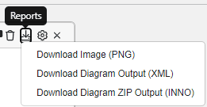
Users may download a PNG Image of the UAF Prodcut Card, or download the view's entities with a XML or INNO output.
If XML or Inno is selected, a window will pop up for users to select what they'd like to include in the output (all options displayed below) and a field to include a file name for the report.
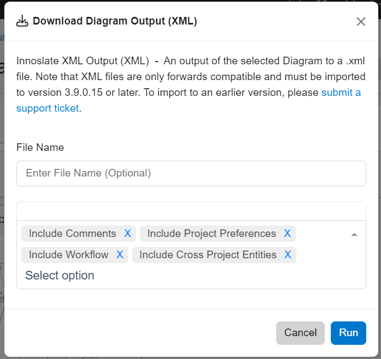
- Edit Widget

Editing the widget allows users to change the UAF Card to another UAF View entirely. The below window appears to change to the desired view. The window will reflect the proper options to pull up the correct UAF View. Below is an example of all the options that may appear.
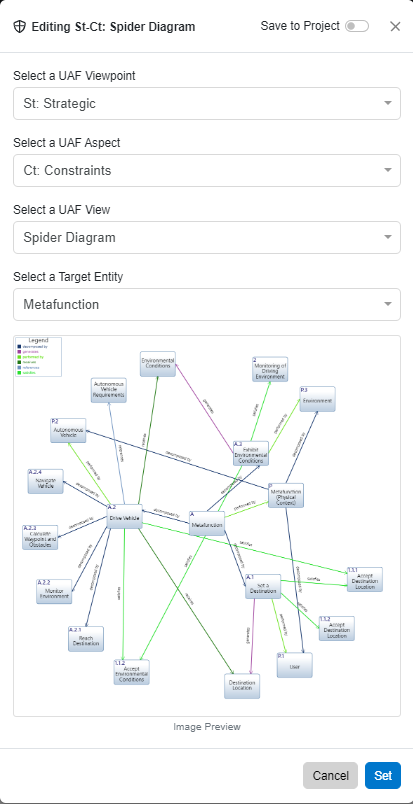
- Close
![]()
The 'Close' option will reove the View card from the Dashboard but will not delete the view.
All Existing UAF Views Widget
The 'All Existing UAF View's' widget contains all existing UAF views in an Innoslate project. This widget is defaulted to appear on the UAF Dashboard after adding UAF to the project.

The 'All Existing UAF Views' widget is where users can conveniently access all of their UAF views in their Innoslate project. Innoslate users have a variety of options available to them for filtering, sorting, searching, interacting and accessing their UAF views within this widget.

When users hover their mouse over the top right of the heading bar a 'Lock' appears so that this widget remains in place on their UAF View's Dashboard. Users can also remove this widget from their Dashboard by clicking the 'Close (X)'button, as shown above.
Also, there is a 'Reports' button for users to export their diagrams as a DOCX or PPTX, highlighted below.

When this 'Reports' button is selected, a window appears with a dropdown to allow users to include name, number, description, created by, created on and modified on data to their report. Then users can select DOCX or PPTX for download. Include a name and select the 'Download' button to create the report.
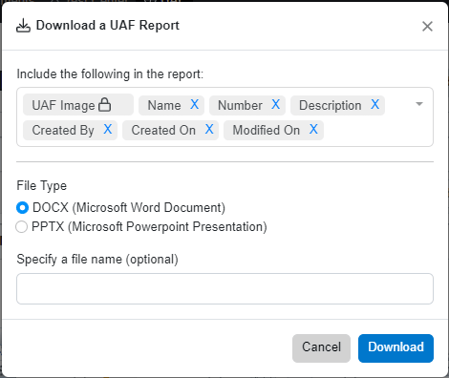
Note, if you filter the 'All Existing' widget for certain diagram types, only those diagram types will be selected for the report.
In the 'All Existing UAF View's' widget users can filter the views by view type:

Sort the views by most recently created date, most recently modified date, name or number:

Users may also use the 'Advanced Search Editor' or the 'Search Field' to query and find a specific diagram:

When a user clicks on the 'Advanced Search Editor' a pop up will appear:
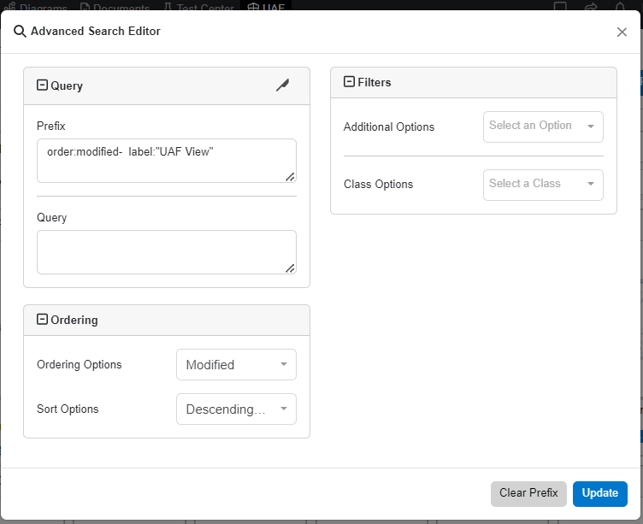
The 'Advanced Search Editor' will reflect the previous sort and filter options discussed from the upper left side of the 'All Existing' Widget. It also provides users the ability to add on and build their query in the pop-up window. Users can choose from a variety of ordering and sorting options, such as ascending or descending, and utilize additional options to effectively search for views.
The 'Search Field' allows users to type in their query for a specific type of view or clear their query here:
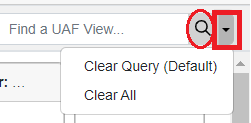
Users can also easily browse through their UAF views by paging on the lower left corner and select the number of diagrams they prefer to display in this widget with the 'Tiles per Page' dropdown on the lower right corner.

UAF Card Options in the All Existing Diagrams Widget
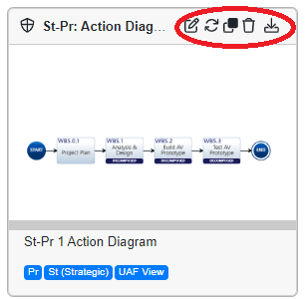
- Edit Entity

Clicking on the 'Edit Entity' icon will open a pop-up that enables users to modify the root entity of the view, known as the view's root entity. This feature allows users to edit fields such as the root entity's name, number, description, and labels. Please keep in mind that for a UAF view, the label is crucial as it differentiates the view from any other view and designates it to be on the UAF dashboard.
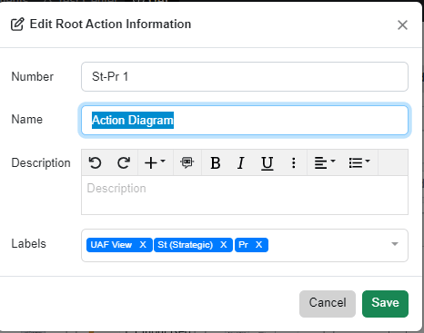
- Refresh Image

- Clone Diagram

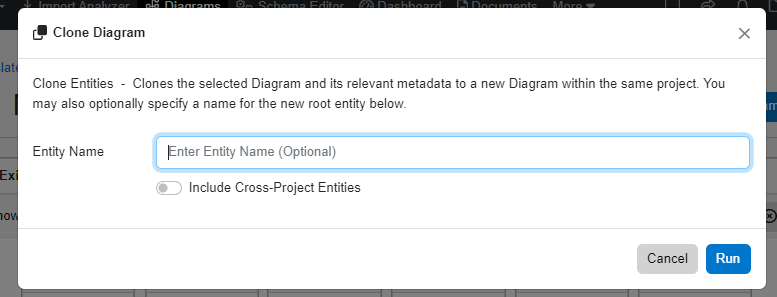
- Delete

Users have the option to remove a UAF card by clicking on the 'Delete UAF View' icon. It's important to note that although the icon says 'Delete UAF View,' it won't actually delete the data. Instead, it will remove the UAF card from the 'All Existing' widget and remove the UAF labels that is needed for it to remain ont he UAF Dashboard. To move forward, a confirmation will appear to confirm the removal of the card, but please note that the view's data itself will not be deleted.
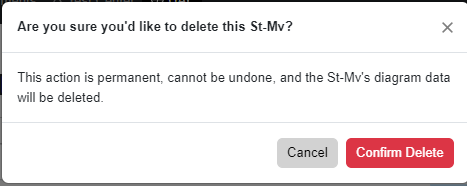
⚠️Since this option does not delete the entities, you can always bring back the view to the dashboard by bringing in the right combination of the view's labels to get the view back. This will usually contain the Viewpoint label, View label, and 'UAF View' label, as shown below.
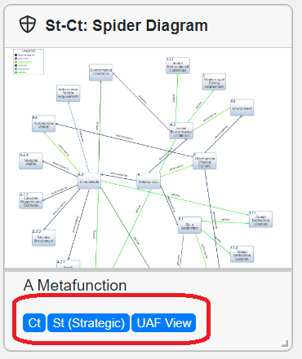
- Reports

Innoslate users can export a PNG of the View's thumbnail image or an XML or INNO of the whole view from the 'Reports' button of a UAF View Card.
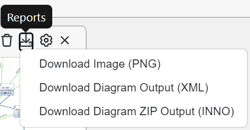
If XML or Inno is selected, a window will pop up for users to select what they'd like to include in the output (all options displayed below) and a field to include a file name for the report.

Create a UAF View
To create a UAF View, the blue 'Create UAF View' button is available on the top right of the UAF Dashboard. This button is actually 2 buttons both are squared off in the image below. The main button is the long rectangle and will start a new root entity (the root entity is also known as the parent entity of the diagram), this is the defaulted option. The second button is the arrow dropdown and gives users the options to start a new diagram or start one with an already existing entity as the diagram's root entity.
It's critical to note when creating a UAF view in Innoslate, depending on the UAF view selected Innoslate will guide users to create a 1) Viewpoint, 2) Aspect and 3) View or be directed to create a 1) Viewpoint and 2) View. No matter how creating the UAF view routes a user, it will always end on a Specify step to specify a Name, Number and Description for the Root Entity of the UAF View. For more information on the UAF mapping please find that here.
Create New UAF View Directions
1. A window will pop up where Users will select which UAF Viewpoint they desire, then select 'Next'. Note, users may type in the field to pull up their desired viewpoint or use the dropdown.

2. Depending on the exact UAF Viewpoint being chosen, it will direct users to select the View or the Aspect in this next step. Below is an example of the Aspect step. Users will select which UAF Aspect they desire, then select 'Next'. Skip to Step 3 for View.

3. Users will next select the desired View for their view.

4A. For a new View, specify the Name, Number and Description field of the Root Entity of your desired UAF View.

4B. If using an Exisitng Entity, select the existing Entity desired to use as the Root Entity, note users can recall entities from another project with the gear icon on the right.
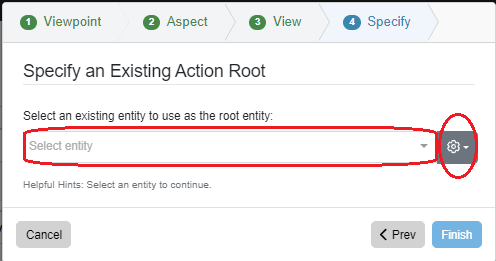
5. Select Finish to be directed to the view to begin creating your new UAF View.

To continue learning about UAF Dashboard, Click Here.
(Next Article: UAF to Innoslate Schema Mapping)
